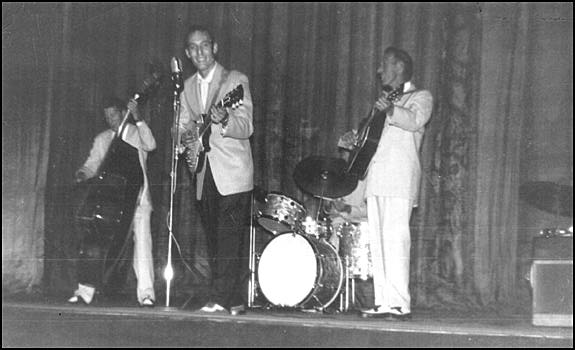| Rockabilly |
| One of the most dominating
aspects of the Beatles early repertoire was the country-tinged music that
came out of the American south, particularly around Memphis and Sam Phillips's
Sun Records. Early Elvis Presley is an example of this style of guitar-dominated
bare-bones blues-country combination. In many initial cases, rockabilly
(or more derisively, "hillbilly music") country musicians took
blues and rhythm-and-blues songs and reinterpreted them. Elvis stripped
the horn section from Wynonie Harris's "Good Rockin' Tonight,"
and Bill Haley did the same with Joe Turner's "Shake, Rattle, and
Roll." |
| The Beatles' favorite
source was Carl Perkins. Indeed, George Harrison breifly changed his name
to "Carl Harrison" in acknowledgement of one of his musical
inspirations. Moreover, Harrison's guitar solos often evoked his love
of this repertoire, flavoring much of their music. The Beatles recorded
several of Perkins' songs (usually with either Harrison or Starr singing),
notably "Everybody's Trying to Be My Baby" and "Honey Don't."
However, they also recorded work by the country mainstream (Buck Owens'
"Act Naturally") and the extraordinary cross-over artist, Arthur
Alexander, whose songs range from country standards ("Detroit City")
to pop mainstream ("Anna"). |
| Song |
Original
Recording |
Beatles |
| "Everybody's
Trying to Be My Baby" (Perkins) |
Carl Perkins,
March 1956 |
Harrison, Oct-Nov
1964 |
| "Honey
Don't" (Perkins) |
Carl Perkins,
December 1955 |
Starr, October
1964 |
| "Matchbox"
(Perkins) |
Carl Perkins,
January 1957 |
Starr,
January 1957 |
| "Act
Naturally" (Voni Morrison & Johnny Russell) |
Buck Owens,
1963 |
Starr,
June 1965 |
| "What
Goes On" (Lennon & McCartney) |
|
Starr,
November 1965 |
|
| One of the most important
aspects of rockabilly that the Beatles adopted was the instrumentation
of the ensemble: lead guitar, rhythm guitar, bass, and drums. Neither
the Beatles nor Carl Perkins were were alone in using this arrangement
(Elvis used it, as did Buddy Holly), but by embracing this format they
embraced a timbre. They would take this sound and apply it to songs from
other genres, with George Martin modifying it further by adding piano. |

Clayton Perkins, Carl
Perkins, W.S. "Fluke" Holland (hidden), and Jay Perkins |
| Lennon
and McCartney's Songwriting/Performance Models |
